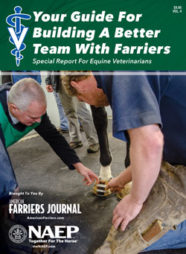Embarking on a hoof-care career is no easy task. It takes several years to establish a successful farrier practice, so it is crucial to make an informed decision on where you will build that business.
Often, aspiring farriers will elect to set up shop in the areas where they grew up. Hopefully, that area is prosperous and populated with plenty of good horses. If not, moving to another area will be in the best interest of a footcare practice.
Once you are established in a home and work life, it is difficult to move and start over in your practice. Just the expense of moving can be considerable, plus the lost income during the time you are finding new clients.
Networking with other farriers, establishing relationships with local veterinarians and finding a mentor in the new area can speed up this process of re-establishing your business. However, this process will require the same dedication and patience as it did when you launched your career.
Things To Consider
Everyone has priorities in life that are different from everyone else. Lifestyle may be more important to you than making as much money as possible. Consequently, what may be a good decision about a good location for one farrier may not be suitable for another.
Deciding where you will relocate should be based on the values that are important to you and your footcare practice.
Re-establishing a practice in a new area can create a financial hardship for you.
Specializing in various disciplines is becoming the norm in farriery.
I moved early in my career from central Minnesota to southeast Wisconsin. Here are some things I took from that experience for you to consider:
What part of the country do you want to live in? While your farrier career is important, it will not take up your whole life. Most people want to live among people who are culturally alike. If you grew up near the oil fields of Texas, you may not like living in eastern Massachusetts.
Weather may seem like a fickle consideration, but it isn’t. Can you tolerate extreme heat or cold?
Do you want to live in an urban, suburban or a rural setting? Yes, ZIP code matters. People have strong ideas about this for one to be happy.

Most farriers I know live in the suburban to rural categories. However, a positive trade-off with heavily populated urban settings is that there are more wealthy people with expensive show horses. Consequently, they are used to paying more for the cost of living, including the services of a competent farrier. Every area has a loose set of going rates for shoeing. In big metropolitan settings, those rates are generally 40% to 60% higher than in the rural areas surrounding it.
There are downsides to the urban setting, though. Your expenses will be higher in relation to the cost of living along with stressful time wasted in traffic, which eats into your time and income.

How important is making a lot of money? If making as much money as possible shoeing horses is your main goal, I urge you to follow American bank robber Willie Sutton’s advice. When asked why he robbed banks, Sutton replied, “Because that’s where the money is.”
The same is true for farriery. If you want to earn as much money as possible — you have to go where the money is. That’s how I determined this list of 20 hot spots.

In affluent urban areas, there are more people with high incomes and, therefore, more disposable income. Horse sports are a very popular pastime for these people, particularly women. Having the best care for their horses is so important that they will happily pay premium prices for premium services.
What kind of horses do you want to work on? Do you want to work on show horses with the pressure they can generate or backyard horses with much less stress? Finding backyard horses to shoe is very easy because they are dispersed across the entire country. If you want to exclusively shoe a particular discipline, you will find that they are grouped together in different areas of the country.

The people you work for may also determine the discipline you choose. Every discipline has a profile or personality of its own. Some disciplines, such as the racehorse industry, are populated by professionals who see the horses as a business and take that approach with their clients. Other disciplines are dominated by dedicated amateurs who can be very intense about competing.
Everyone has preferences about the type of people they want to be around and this can be as big of a factor as the type of horse. At any rate, it is good to get exposure to as many groups as possible to make an informed decision.

Like it or not, we are in the age of professionals who specialize — including farriers. When embarking on your new career, I strongly advise spending time with farriers who have specialized in a particular discipline to find out if that is for you. Examples are racehorses, harness racers, sport horses, Western horses, endurance, draft, long-footed show horses, short-footed gaited horses and backyard horses.
The types of horses you want to work on often will dictate where you should establish your business. There are pockets everywhere, but some examples of concentrated areas in the United States include:
- Western horses in the Far West, West and Southwest.
- Sport horses in the Northeast.
- Long-footed gaited horses in New England, Tennessee, Kentucky and Missouri.
- Thoroughbred racehorses in Kentucky, California, New York and Florida.
- Standardbred racehorses in Kentucky, Illinois and the Northeast.
- Draft horses in the Central and Northeast.
- Polo in Florida, California and the Northeast.
- Breeding farms in Kentucky, Florida, Texas, Oklahoma and California.
Not Living By Circumstances
As we go through life, often there is little that we can do with the vagaries of fate, but you can’t worry about what may happen. Plan for what will happen. We still control the direction of our lives in spite of those events. Such is the opportunity you now have.
Upon graduation from farrier school or completion of a mentoring program, aspiring farriers have the opportunity of guiding and shaping their careers to coincide with their goals. To be successful, you have to make many decisions, such as the location to build the farrier practice you want.
You can float with the current and hope for the best, or you can grab an oar and row like hell. Good luck.








